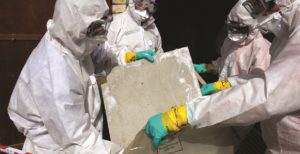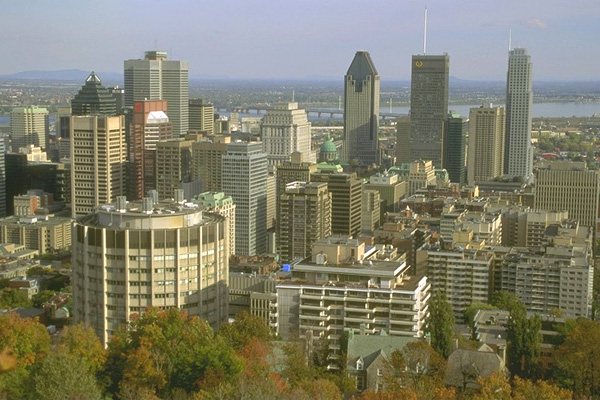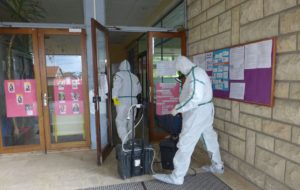Summary of assessement of the presence of asbestos
1997 First report on the presence of asbestos fiber in a educational establishment
In March 1997, At the CLSC des îles annual public meeting, a citizen complained of the presence of asbestos in the coating ceiling at high school : École polyvalente de l’Étang-du-Nord aux Îles-de-la-Madeleine. Des Îles School Board, had made a summary analysis of the material covering the ceilings on the request of the CLSC, and the results have dismantled the presence of chrysotile and amphibole in the insulation. Therefore, an analysis of the air quality in the high school was requested in turn from Des Îles School Board to the CLSC. The at work health team of the Gaspésie-Îles-de-la-Madeleine public health department took this mission in charge. The sampling results showed the presence of amosite and chrysotile in the insulation. The latter was projected as a flock across the ceiling on most ceilings of the high school. The material was in open air and damaged in some areas. Dust samples, as well as ambient air were also collected. Again, amosite and chrysotile were present in the dust. In the air, asbestos concentrations ranged from 0.15 optical fiber per cubic centimeter of /cc to 0.26 of /cc [-] for samples taken during the day .1 Since some studies have published the presence of asbestos in the air by counting: electrical fibers per square cube, six samples were submitted to an electronic analysis transmission. The results showed that amosite fibers concentrations were ranged from 0.002 to 0035 electronic fibers per cubic centimeter (ef / cc) for samples taken during the day. At this time in 1997, in Quebec there were no environmental exposure standards. However, Ontario fixed the norm in the air at 0.04 electronic fibers per milliliter (ef / mL). We wonder then, if these measured doses are dangerous for the high school occupants? The report provides as comparison, it is estimated, that a worker should be exposed to asbestos for 500 years at found doses in the high school before developing asbestosis. In regard to cancer, there is a significant risk, but difficult to quantify precisely. Since there are no studies on the field at this time, an estimate of the risk was made from mathematical models extrapolating the results in highly exposed workers. Read more on asbestos related diseases By transposing the obtained data, according to Goldberg and Camus, the risk of cancer associated with asbestos due to the highest result obtained at the high school (0.035 ef /mL) is 7 per 10,000 people exposed for workers ( 0,035 ef / mL , 20 years , 240 days / year , 8h / d ) and 2 per 10,000 people exposed for students (0.035 ef / mL , 5 years , 180 days / year , 6h / d) .1These results confirmed that there were asbestos fibers in the air at the high school, particularly amosite, a known carcinogen, and that the coating ceiling was damaged. These results were considered worrying by the Department of Public Health since we are talking about a public building and a school. In addition, high proportion of amosite was measured. For these reasons, the Department of Public Health asked the School Board to take the necessary measures to lower the concentration of asbestos fibers in the air and stop the deterioration of the coating ceiling.
Note that in 1997, the Department of Public Health was faced to the lack of clear intervention criteria concerning the concentration of asbestos in the air in public places. The Department of Public Health had recommended that the authorities were in duty to define the health risks associated with environmental exposure to asbestos fibers according to various exposure scenarios to better guide public health interventions in public places.
Actions taken by the Ministry of Education of Quebec (MEQ ) and the Ministry of Health and Social Services (DHSS )
1998 First report on the presence of asbestos fiber in a school
The mentioned above, 1997 report, was a trigger for a series of studies and pilot projects carried out by the IRSST (2) and The INSPQ (3-4). Indeed, in March 1998, the Ministry of Education of Quebec (MEQ) and the Ministry of Health and Social Services (DHSS) had initiated a preventive approach in schools to assess the possibility of exposure to asbestos. A management criteria of 0, 01 (ef / mL) was determined by the DHSS to identify possible emission sources of asbestos fibers in the public buildings air.2 Within this preventive approach, a study was initiated to collect a significant number of samples in school buildings locals whose flocked materials were much degraded, and assess concentrations of asbestos fibers in the air to document the capacity of these materials to generate fibers in the air.2 The mean concentration was 0.0031 (ef / mL) (77 samples from 17 schools), which is below the management criteria of 0.01 (ef / mL) adopted by the DHSS. Gyms, especially those with a low ceiling, in which run ball activities took place, have recorded higher concentrations of asbestos fibers: up to eight times the management criteria. However, under normal occupation conditions, asbestos fibers levels in the air were below the management criteria. This is no longer true in places where activities fostered contacts with materials. Therefore, the report concludes that the sprayed asbestos even degraded; do not give rise to levels of fibers in the air higher than the management criteria; unless physical contact took place with the sprayed asbestos.2 2 www.irsst.qc.ca In the same line of thought, these data were confirmed by a pilot project done by the INSPQ (3) in school locals with materials containing asbestos in poor condition. According to results published in April 2003, it was confirmed that under normal conditions, concentrations of asbestos fibers in the school buildings are in the range of levels found in ambient air outside. Moreover, it has been estimated that “in the worst case” : a six years exposition, between the ages of 5 and 11 years, occurring in a highly contaminated school (0.005 (ef / mL) mixture of amphibole fibers and chrysotile ) engendered a risk of dying from lung cancer or mesothelioma of about 30 cases per million people exposed.3 3 L’amiante dans les édifices publics, 15 avril 20002003 Summary and recommendations reports
In 2003, the INSPQ published a summary and recommendations reports: Fibers of asbestos in the air inside and outside & Epidemiology of diseases related to asbestos exposure in Quebec. Here is a quote of the key findings: In March 1998, a preventive approach regarding sprayed asbestos in elementary and high schools in the province of Quebec was undertaken. This consisted of three steps: identifying school buildings where there was sprayed asbestos, the qualitative assessment of the conservation status of sprayed asbestos and the remedial action to perform. Some 508/3300 buildings owned by 55 school boards have been identified as “where there is a sprayed asbestos” among the 72 existing school boards (with some 3,300 buildings used for teaching). Excluding the fifty buildings whose flocked asbestos locals were not frequented by students, it was found that about 12% of all school buildings in Quebec had sprayed asbestos. The locals visited were classified according to an evaluation grid with three rating: rate 1 and 2 (whose materials are not damaged or begin to deteriorate and require periodic surveillance measures and preventive maintenance); rate 3 ( whose materials are degraded and require corrective action at the earliest, according to a schedule established by the school boards). Of the 508 buildings, 125 locals were rated 1, 13 listed locals were rated 2 and 292 listed locals were rated 3. So far, in year 2000, 60% of these repair works has been done.4 4 www.inspq.qc.ca2008 to 2012 Evolution of asbestos situation assessment in Quebec schools
Following these reports the media and written press were interested in schools situation (unsafe buildings, questionable or even dangerous air quality). Their indignation was because the published studies done by government agencies kept secret the institutions names, those who obtained a rating of 2 or/and 3. Articles and reports published / set wave between 2008 and 2012 on the subject, see references 5 to 12.- www.ledevoir.com/societe/education
- http://exruefrontenac.com/nouvelles-generales
- http://www.lapresse.ca/actualites/sante
- www.lapresse.ca/dossiers/la-controverse-de-lamiante
- www.lapresse.ca/debats/chroniques/patrick-lagace
- Almost every school have an asbestos problem
- http://ici.radio-canada.ca



